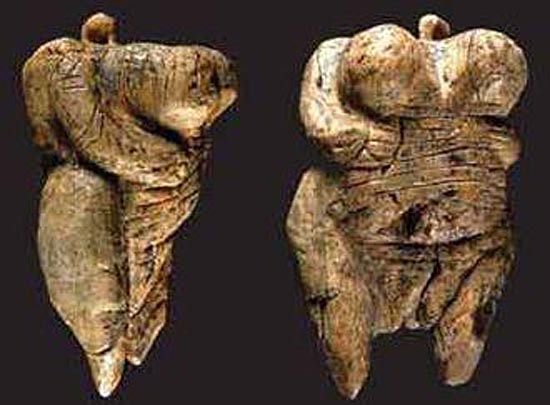
Venus Street
40 000 – 24 000 BP
In the Beginning
there was
Flute Music,
Dancing
and Venus
The Steatopygous Venuses of the Gravettian
Middle-Upper Paleolithic 40 000 – 20 000 BP
The so-called
“Venuses” (Latin plural veneres)
have been famous for their steatopygous shapes ever since the early
1900s when they were
first
discovered. Mostly headless and feetless, small mammoth ivories they
were found with a few exceptions along “Venus Strasse”, a
corridor following the Danube valley just south of the Würm ice
sheet (LGM, Last Glacial Maximum, 20-18 000 BP) and north of the
Alps. H. sapiens passed through this corridor (~40-25 000 BP) just
before the climate turned very cold. For that reason these figurines
are usually attributed to H. sapiens, not to Neanderthals. Still he
didn't bring this form of art with him, it must have been
indigenous.
In any case these small figurines are connected with a
hunter-gatherer life style – and the presence of large numbers of
mammoths. They can easily be carried and have a “good feel” -
especially the steatopygous variety.
Much speculation has centered
around their meaning: were they fertility symbols, matriarchal
goddesses, protectoresses of the animals, or sex symbols? I think
they were all of that, a tactile object representing the
all-pervading female presence in life. Man is truly expendable in a
life cycle of birth and death, especially if there are more women
than men in the population, as some paleogenetic statisticans
suggest.
It is thought provoking that woman almost completely
disappears from the great cave paintings that followed after 30 000
BP.
Lady of the Hohle
Fels
Schelklingen near
Blaubeuren, Donautal
40 000 BP (40 000 Before Present or 38 000
BC)

The Venus of Hohle Fels is an Upper Paleolithic figurine found near Schelklingen, Germany. It is dated to between 35,000 and 40,000 years ago, belonging to the early Aurignacian, at the very beginning of the Upper Paleolithic, which is associated with the assumed earliest presence of Homo sapiens (Cro-Magnon) in Europe. It is the oldest undisputed example of Upper Paleolithic art and figurative prehistoric art in general.
It is made of a woolly mammoth tusk and had broken into fragments, of which six have been recovered, with the left arm and shoulder still missing. In place of the head, the figurine has a perforation so that it could have been worn as a pendant.
Geissenklösterle Cave
Near
Blaubeuren, Donautal
35 000 – 32 000 BP
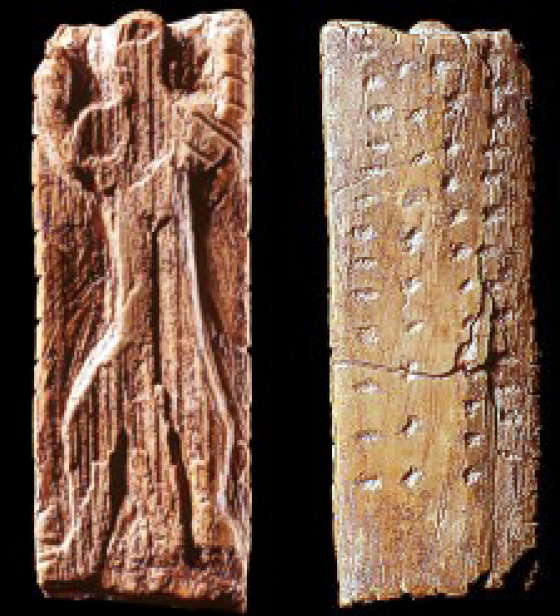
Front
and back of the "Adorant", ivory carving,38 mm, 33 000 BP
The Worshipper, called 'Adorant', is one of the oldest, most impressive and mystifying statuettes from the Ice Age. It was discovered in an ashy bone layer near a possible hearth. Unfortunately, the surface of this small flat segment of ivory is in very poor condition. Nevertheless, the bas-relief of a human being with raised arms, who seems to be either saluting or threatening, can be distinguished. The raised arms might also be interpreted as an attitude of worship, so the statuette was named the 'Adorant'.
On the back side B together with the four edges is a series of notches that are clearly set in an intentional pattern. The edges contain a total of 39 notches in groups of 6, 13, 7 and 13. A further 49 notches on side B are arranged in four vertical lines of 13, 10, 12 and 13 respectively plus a further notch that could be in either of the middle two lines.
“This Lunar Calendar, the grouping of notches on the plate suggests
a timerelated sequence. The total number of notches (88) not only
coincides with the number of days in 3 lunations (88.5) but also
approximately with the number of days when the star Betelgeuse
(Orion) disappeared from view each year between its heliacal set
(about 14 days before the spring equinox around 33,000 BP) and its
heliacal rise (approximately 19 days before the summer solstice).
Conversely, the nine-month period when Orion was visible in the sky
approximately matched the duration of human pregnancy, and the timing
of the heliacal rise in early summer would have facilitated a ‘rule
of thumb’ whereby, by timing conception close to the reappearance
of the constellation, it could be ensured that a birth would take
place after the severe winter half-year, but leaving enough time for
sufficient nutrition of the baby before the beginning of the next
winter. There is a resemblance between the anthropoid on side A and
the constellation Orion.”
From Astronomical
Heritage
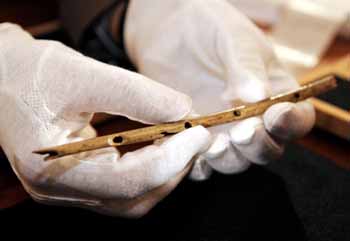
A
40 000 years old flute made from a waterbird bone
one of several
found in the area, Photo from crystallinks
see
also National
Geographic
Vogelherd Cave, a Bestiary of
Aurignacian Animals
Lonetal
near Stetten, Schwäbische Alb
35 000 BP
|
|
|
|
|
|
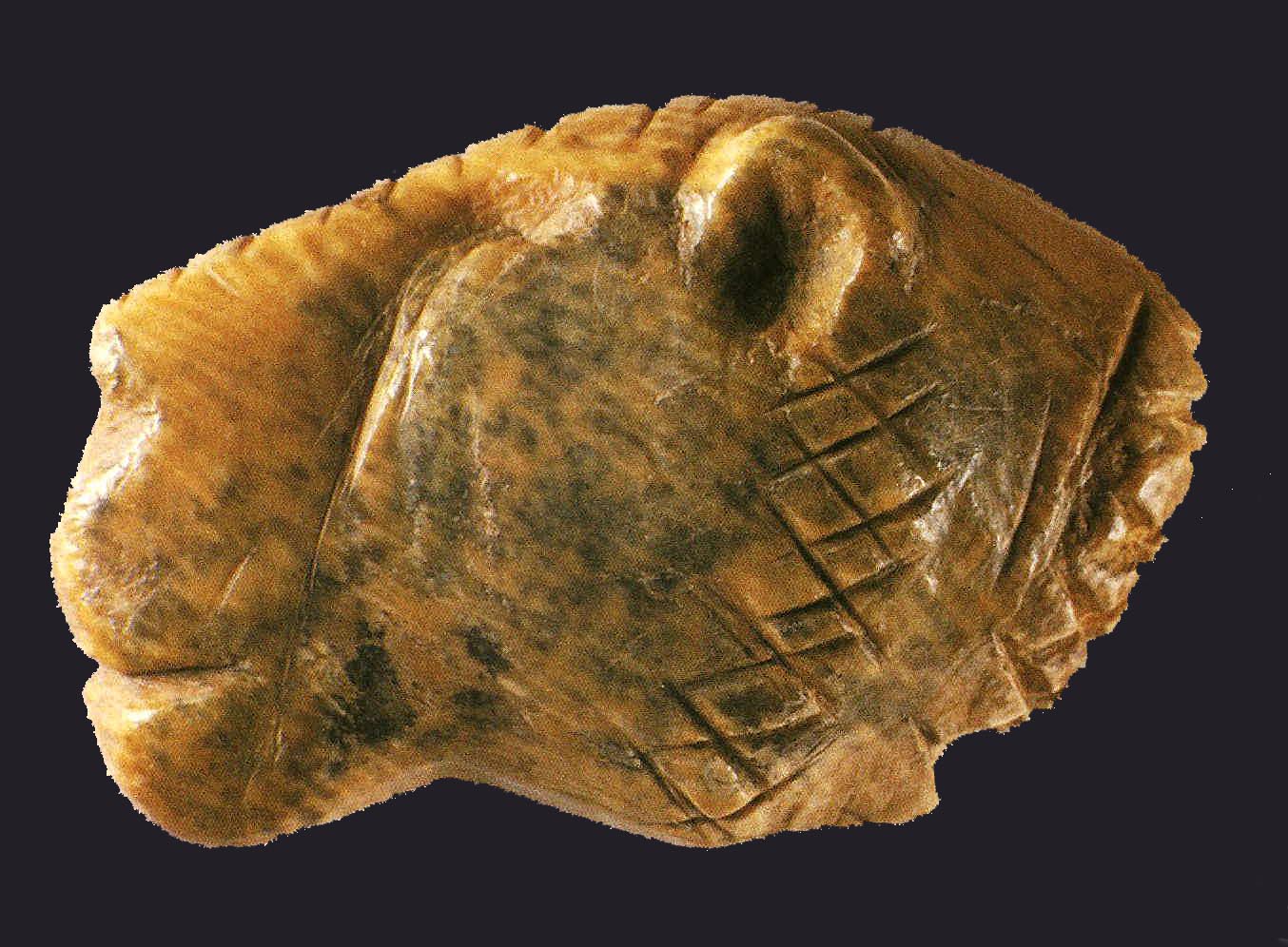
Head of a cave lion, 25 mm
The Lion Man from
Hohlenstein-Stadel
Lonetal
near Stetten, Schwäbische Alb
32 000 BP
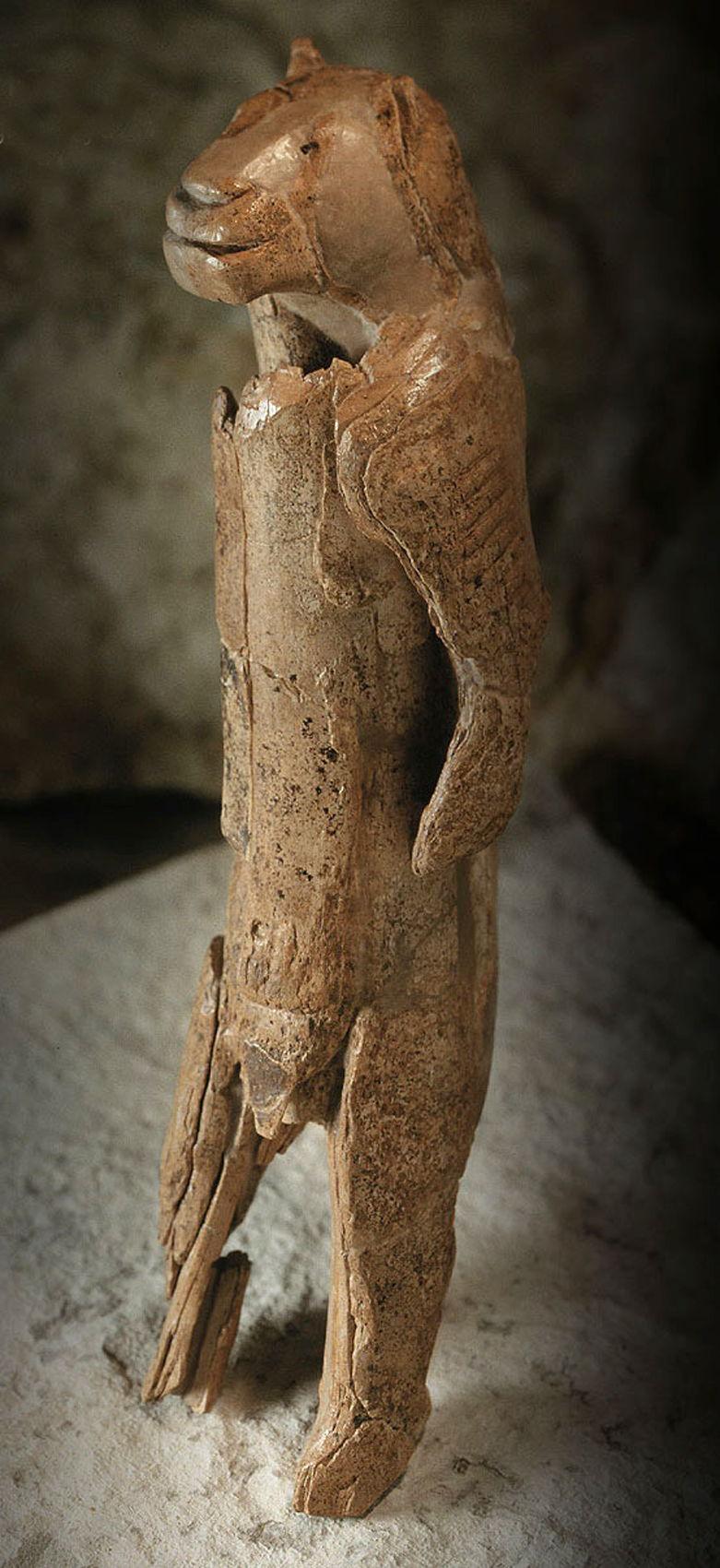
The
Lion Man, ivory, 296 mm, app. 32 000 BP
The 'Lion Man', made from the tusk of a mammoth is about 30 cm high. Its creator carved and polished the piece. An experiment revealed that the carving took about 320 hours. The original is badly damaged but no one knows its exact appearance. The reason is that because of the hurried completion of the pre-war excavations, many splinters from the piece were overlooked. The present form was completed in 1988, and consists of 220 pieces. About 30 percent of the body is missing. The surface has splintered off a large part of the statue.
The enigma is that it is uncertain whether a mythical half-lion half-human is depicted, or perhaps a magician under a cloak. The six stripes on the upper left arm can be interpreted as bulbous ornamental marks, but it is unknown what was on the missing right arm.
Even the sex is uncertain. The prehistorian Joachim Hahn suggested
that the plate on the abdomen might be a flaccid penis. The
palaeontologist Elisabeth Schmid classified this feature as a pubic
triangle. The statue had been touted as an 'icon of the feminist
movement', complained Kurt Wehrberger of the Ulmer Museum, which
holds the treasure. For some women it is clear: prehistory was a
matriarchy and Eve was an Amazon. Instead of cooking and looking
after children, women would have hunted mammoths and also been part
of magic rituals. The debate is still not decided, but that could
change. New fragments of the 'lion man' have been
discovered....
Don's
Maps
Lady from Galgenberg
Stratzing-Krems/Rehberg Austria
30 000 BP

Lady
from Galgenberg
7.2 cm high, green serpentine rock, broken in
several places, Austria
Lexikon
Not all Aurignacian "Venuses" are steatopygous! This one,
breasts flying, is dancing with a raised arm
It is highly
probable that the statuette was manufactured at Galgenberg. The
occurrence of amphibolite schist at a distance of several hundred
metres from the site, as well as many small fragments of this raw
material in the area of the fragments of the statuette, which may be
waste from the original carving, support this assumption.
An
extensive discussion of the archeological details is found at Don's
Maps
Venus of Laussel
Perigord, France
27 000 BP
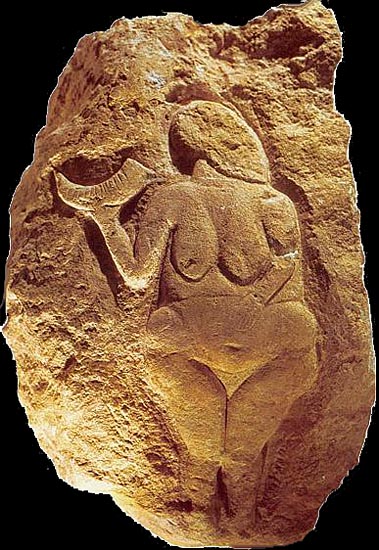
Venus
of Laussel, sandstone basreleif, 45cm, Gravittian, 27 000 BP
“La Femme à la Corne”
This low relief
venus is from Laussel, Dordogne. 44 cm (17.5 inches) high. Musee
d'Aquitane, Bordeaux. The body swells out towards the viewer from
this convex block of limestone. It formed one of a set, a frieze
which included other female figures and a male figure.
It
probably dates to 27 000 - 22 000 b.p. Although now detached, it
should be classed as parietal (non portable, in place) rock art since
it was originally carved on a block of 4 cubic metres (140 cubic
feet), and was originally covered in red ochre. The bison's horn and
the series of 13 lines on it have often been linked with the moon or
menstruation. The lines may represent the thirteen days of the waxing
moon and the thirteen months of the lunar year.
The venus was
discovered in 1911 by a physician named J. G. Lalanne carved into the
wall of a limestone rock shelter (named Laussel) in the Dordogne not
far from Lascaux. The shelter, under an overhang, is a terrace over
300 yards long which looks out over the valley below. Although
originally thought to have been a dwelling site, it is now believed
to have served as a ceremonial center.
Don's
Maps
The Lady of Willendorf
near Melk on the Danube
26-24 000 BP
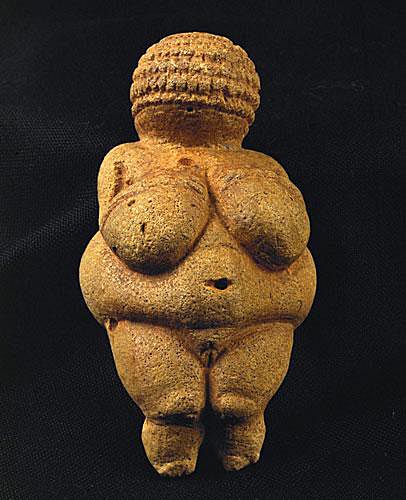
The
first and most famous Venus
11.5 cm high carved from an oolitic
limestone that is not local to the area, and tinted with red
ochre.
dated to between 24 000-22 000 BC
The Venus of Willendorf is an 11.5 cm high statuette of a female figure dated to between 24,000 B.C.– 22,000 B.C.. It was discovered in 1908 by archaeologist Josef Szombathy at a paleolithic site near Willendorf, a village in Lower Austria near the city of Krems. It is carved from an oolitic limestone that is not local to the area, and tinted with red ochre.
Since this figure's discovery and naming, several similar statuettes been discovered elsewhere.
Venus of Lespugue
Haut
Garronne, France
24 000 BP

Venus
of Lespugue, Haut Garronne (replica), the head may have been added,
24 000 BP
150 mm, tusk ivory, damaged during excavation
Of all the steatopygous Venus figurines discovered from the upper
Paleolithic, the Venus of Lespugue, if the reconstruction is sound,
appears to display the most exaggerated secondary sexual
characteristics, especially the extremely large, pendulous breasts.
According to textile expert Elizabeth Wayland Barber, the statue
displays the earliest representation found of spun thread, as the
carving shows a skirt hanging from below the hips, made of twisted
fibers, frayed at the end (visible only from the back).
It has
been observed that the proportions of the statue mimic the ratios of
the modern Dorian mode. It has also been conjectured that this
relationship demonstrates that the cultural advancement of
paleolithic peoples have been substantially underestimated!
Wikipedia
Lady
Moravany
Moravany nad
Nahom near Piestany, Slovakia
22 800 BP

Less
known but more realistically formed is the Moravany Venus, ivory, 7.6
cm, 22 800 BP
It may be that the venus never had a head. It appears likely that there were never any feet shown, which is normal for venus figures. It can be seen here that the arms are not seen to be important. The left arm is missing, perhaps broken off, but the right arm is barely indicated.
Dolni Vestonice, Moravia
Mammoth
Hunter Camp
27-20 000 BP
Dolni Vestonice is an archaeological site near the village of the same name in the Czech Republic. The site is unique in that it has been a particularly abundant source of prehistoric artifacts (especially art) dating from the Gravettian period, which spanned roughly 26,000 to 20,000 B.C. In addition to functional gear, the artifacts found at Dolni Vestonice include carved representations of animals, men, women, personal ornaments, enigmatic engravings
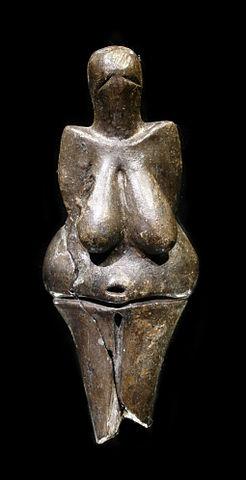
The
Venus of Dolni Vestonice
This figurine, together with a few others from nearby locations, is the oldest known ceramic in the world, predating the use of fired clay to make pottery. It has a height of 111 millimeters (4.4 inches), and a width of 43 millimeters (1.7 inches) at its hips and is made of a clay body fired at a relatively low temperature. A tomograph scan in 2004 found a fingerprint of a child estimated at between 7 and 15 years of age, fired into the surface; the child who handled the figurine before it was fired is considered to be an unlikely candidate for its maker.
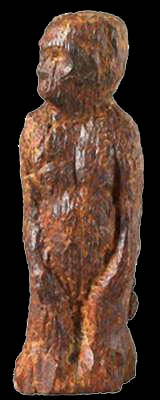
“Venus
III” from Dolní Věstonice, from a grave, mammoth ivory, daubed in
red ocher. Middle Upper Paleolithic
In this view, one can clearly
see that the figure is looking to the side. Almost all Venuses face
forward.
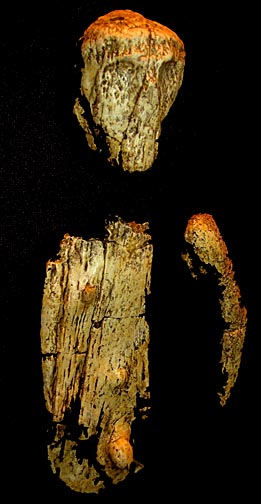
Surviving
parts of a male marionette, mammoth ivory, 20 cm high, 27 000 BP
|
At right is
a reconstruction of the puppet. It was found in the grave of
what has been interpreted as a shaman's, who during his
lifetime had suffered from severe periostitis. He was buried
with his cap sewn with 600 shells, a broken drumstick and
parts of his drum - and this marionette. He must have used it
in healing ceremonies. |
|
|
|
|
"Venus XV" from Dolni Vestonice
Artistically
the most extraordinary sculpture of the Paleolithic
mammoth
ivory, images larger than original, 25 800 BP
The figurine was found at the site and is believed to be a portrait
of a 40-year old woman in a neighboring grave, because of remarkably
similar facial characteristics. The woman was found to have
deformities on the left side of her face. The special importance
accorded to her burial, in addition to her facial deformity, makes it
possible that she was a shaman (priestess) in her time, where it was
not uncommon that people with disabilities, either mental or
physical, were thought to have unusual supernatural powers.
For an
illustrated discussion of several other astonishing “Venus”
carvings found at Dolni Vestonice see Don's
Maps